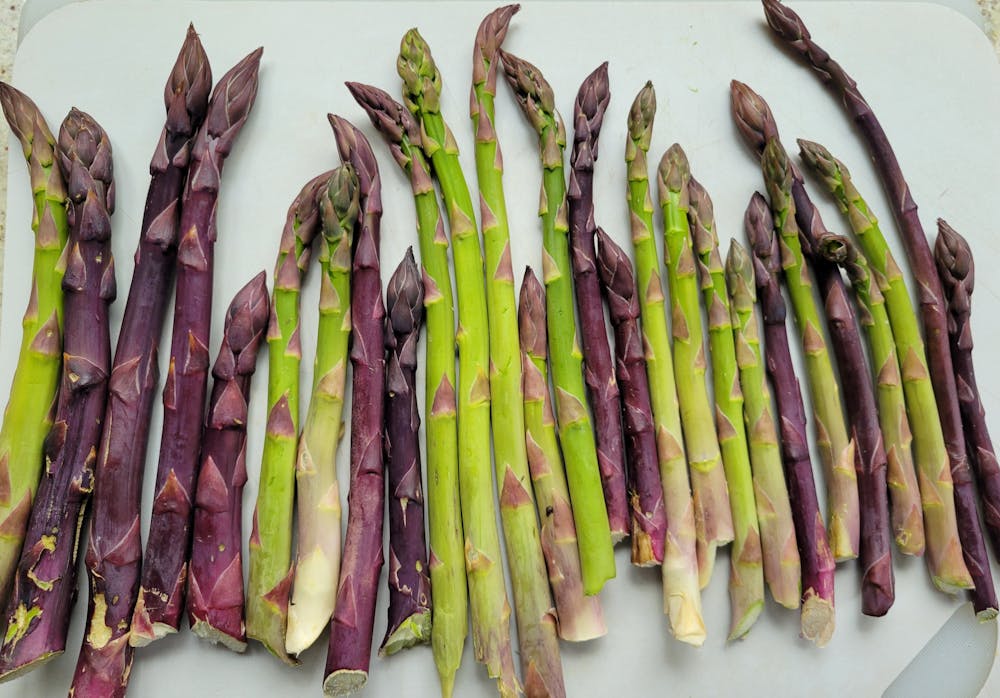Local asparagus has been spotted at Oxford Farmers Market. Shoppers quickly buy up the supply, so it’s important to arrive at the market around 9 a.m., when it opens, in order to take advantage of this newly-stocked item.
For local food fans, availability of locally grown asparagus is the most significant sign of seasonal change in Oxford – never mind graduation, Mother’s Day and the last frost. In Oxford, asparagus marks the beginning of a non-stop progression of seasonal local produce from now until winter.

Scott Downing sells asparagus grown on his farm at Oxford Farmers Market
Most folks know that corn on the cob tastes best when it is freshly picked. The difference between young and old asparagus is even more striking than with corn. Like corn, most of the sugar in asparagus converts quickly to starch.
A decade ago, it was nearly impossible to buy locally grown asparagus in Oxford. The availability of local asparagus is a testament to the faith of several Oxford-area growers. It takes three years before planted asparagus yields edible stalks, and for the first few years, harvests are minimal. That’s a long time for a local grower to wait for a sellable crop.
Asparagus comes in three colors: green, white and purple. Green and white varieties come from the same plant. When they emerge from the ground, asparagus stalks are exposed to sunlight and turn green, but if dirt is piled on top of the stalks to prevent sunlight from reaching them, they will remain white.
White is popular in Europe, but is rarely grown in America, and I have not found it among our local growers. Europeans prefer white asparagus because they think the variation is milder, more tender and less bitter than green asparagus. This time of year, known as Spargelzeit (asparagus time), Germans consume massive quantities of white asparagus at festivals and roadside stands.
Purple asparagus is genetically different from the green and white varieties. It was developed by farmers in northwestern Italy between Genoa and Monaco. The purple color comes from anthocyanins, which are antioxidant flavonoids with anti-inflammatory and anti-cancer properties. Stalks are purple on the outside, but the interior is the same as green asparagus.
Purple asparagus is less fibrous than green and therefore slightly more tender. The purple kind is a bit sweeter because it has about 20% more sugar in its stalk than green asparagus.
Local asparagus can be served with oil and vinegar dressing, or simply as a plateful of local asparagus spears, without adornment. That’s what happened to me many decades ago when I was a student in London and a local friend invited me to dinner at his aunt’s mansion.
At the dinner table, surrounded by an array of crystal, china and silver, the first course, brought in by the butler, was a plate of unadorned steamed asparagus. Not knowing which of the intimidating collection of silverware to use, I waited for others to start eating. To my amazement, these elegantly dressed folks picked up the asparagus spears one at a time with their fingers and popped them in their mouths.
In the heat of the summer, we eagerly await local corn and we consume a year’s worth of corn on the cob in a month. Why not do the same with asparagus in the spring? After all, our local growing season for asparagus is very short.
Enjoy what you're reading?
Signup for our newsletter
Jim Rubenstein is Professor Emeritus of Geography. At Miami, he was Chair of the Department of Geography and Adviser for the Urban & Regional Planning major. He now writes human geography textbooks and consults on the auto industry at the Federal Reserve Bank of Chicago. In Oxford, he is Treasurer of the Board of Directors of MOON Co-op Market.




